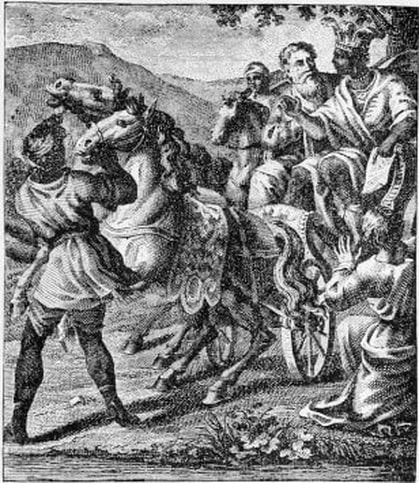Acts 8:26-40
Lesson 237
Read both the "King James Bible" and the "New Living Translation."
In this lesson:
Philip, an angel, and the Ethiopian eunuch.
The church expands southward.
Philip and the eunuch.
(Vintage engraving on exhibit at the New York Public Library.)
(Vintage engraving on exhibit at the New York Public Library.)
Where was -
Azotus -
An ancient Philistine city situated thirty-five miles west of Jerusalem, three miles from the Mediterranean Sea, and north of what is now called the Gaza Strip. Named Ashdod in the Old Testament (Isaiah 20:1), it sat on the prosperous east/west trade route and was one of the Philistine's most important cities. The Philistines captured the Ark of the Covenant, perhaps the most sacred Jewish treasure, from the Israelites and carried it to Ashdod (1 Samuel 5:1). It was displayed next to a statue of their pagan god Dagon (1 Samuel 5:2). Each morning the people of Ashdod found the statue of Dagon toppled over on its face (1 Samuel 5:3-4) and were plagued with tumors (1 Samuel 5:6) until they finally returned the Ark to Israel (1 Samuel 5:11). Today the city is called Esdud.
Caesarea -
A large Mediterranean seaport on the coast of Palestine located thirty-two miles north of Joppa, twenty-two miles south of the modern-day city of Haifa, and seventy miles northwest of Jerusalem. Not to be confused with Caesarea Philippi, a city near the Sea of Galilee. A two-day sail from Tyre, Caesarea was the Roman capital of Palestine, home base to Pontius Pilate, and it housed a large Roman military garrison. Originally named Straton in the 4th century BC, it was renamed by King Herod after receiving the city as a gift from the Roman emperor Caesar Augustus. It was here that Peter converted the Roman centurion Cornelius (Acts 10:1-24), and we saw Paul sail from Caesarea as he fled a murder plot in Jerusalem (Acts 9:29-30).
Azotus -
An ancient Philistine city situated thirty-five miles west of Jerusalem, three miles from the Mediterranean Sea, and north of what is now called the Gaza Strip. Named Ashdod in the Old Testament (Isaiah 20:1), it sat on the prosperous east/west trade route and was one of the Philistine's most important cities. The Philistines captured the Ark of the Covenant, perhaps the most sacred Jewish treasure, from the Israelites and carried it to Ashdod (1 Samuel 5:1). It was displayed next to a statue of their pagan god Dagon (1 Samuel 5:2). Each morning the people of Ashdod found the statue of Dagon toppled over on its face (1 Samuel 5:3-4) and were plagued with tumors (1 Samuel 5:6) until they finally returned the Ark to Israel (1 Samuel 5:11). Today the city is called Esdud.
Caesarea -
A large Mediterranean seaport on the coast of Palestine located thirty-two miles north of Joppa, twenty-two miles south of the modern-day city of Haifa, and seventy miles northwest of Jerusalem. Not to be confused with Caesarea Philippi, a city near the Sea of Galilee. A two-day sail from Tyre, Caesarea was the Roman capital of Palestine, home base to Pontius Pilate, and it housed a large Roman military garrison. Originally named Straton in the 4th century BC, it was renamed by King Herod after receiving the city as a gift from the Roman emperor Caesar Augustus. It was here that Peter converted the Roman centurion Cornelius (Acts 10:1-24), and we saw Paul sail from Caesarea as he fled a murder plot in Jerusalem (Acts 9:29-30).
Study Tip:
Approach Bible study with an idea of what you want out of it.
Make a list of things you're looking for as you study.
Approach Bible study with an idea of what you want out of it.
Make a list of things you're looking for as you study.




